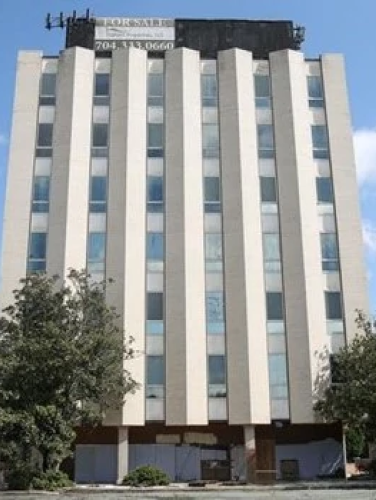
Ervin Building
(ca. 1964)
Prominent real estate developer Charles Ervin housed his namesake firm, once a leading U.S. home builder, in this first skyscraper east of downtown Charlotte.
4037 E Independence Blvd, Charlotte, NC 28205
The Ervin Building, Independence Boulevard’s first large-scale commercial structure and the first skyscraper east of downtown Charlotte, was the headquarters of the Ervin Company, a significant mid-20th century residential development firm headed by Charles Conger Ervin (1924-2006). The seven-story Modernist Ervin Building was the work of architect Scott Ferebee, a one-time president of the American Institute of Architects who was instrumental in founding the School of Architecture at UNC-Charlotte.
Property Quick Links
A native of Rutherfordton, North Carolina, Charles Ervin was the youngest of the nine children of Reverend James O. and Stella Dove Conger Ervin. He grew up in and around Charlotte before graduating from Duke University. Following his service in the U.S. Navy – including a stint as an officer on the U.S.S. Bunker Hill aircraft carrier, Ervin returned to Charlotte to begin a construction career as a bricklayer. He built his own house in 1947. Almost immediately after its completion, Ervin received an offer to buy his house. That immediate first success led Ervin to establish his own construction company. What started as a two-employee local construction firm building custom homes for customers that already owned land quickly transitioned to developing all-inclusive planned communities. Within its first year of operation, the Ervin Company sold $2.5 million worth of houses. By 1964, it had become the largest home builder in the southeastern United States.
Ervin started with the development of Country Club Hills in 1950 and Eastway Park in 1952, evidencing Charlotte’s rapid growth east of downtown. His company provided all services for its developments, including landscaping and road and sewer construction, making it a one-stop-shop for new neighborhood developments. Other early Ervin Company neighborhoods included Beechwood Acres (1953), Providence Park (1954), and Markham Village, Longwood, and Oaklawn Park, all started in 1955. As most housing developments of that time were racially segregated, Oaklawn Park was Ervin’s first housing development specifically for Charlotte’s African American community. By 1958, the Ervin Company was the South’s largest home builder; House and Home magazine called it “perhaps the nation’s largest custom home builder.” At that time, an Ervin house cost between $8,000 and $50,000, but each Ervin development kept a relatively tight housing price range to create a homogeneous appearance. The developments were primarily of Traditional and Colonial Revival architecture located on curvilinear roads, avoiding the riskier Modernist designs prevalent at that time. By 1959, the Ervin Company had its own financial department to help potential buyers, and later opened its own furniture retail store (also on Independence Boulevard) so homebuyers could purchase an interior design package with their new home. In 1960, the company became the nation’s seventh largest homebuilder, having built one-third of all new homes in Charlotte. By 1968, the Ervin Company had constructed some 10,000 homes, 2,000 apartment units, and 2 million square feet of retail and warehouse space (cumulatively worth some $300 million) in the greater Charlotte area, including the notable Tega Cay. Charles Ervin sold his namesake company to the American Cyanamid Corporation in 1970.

